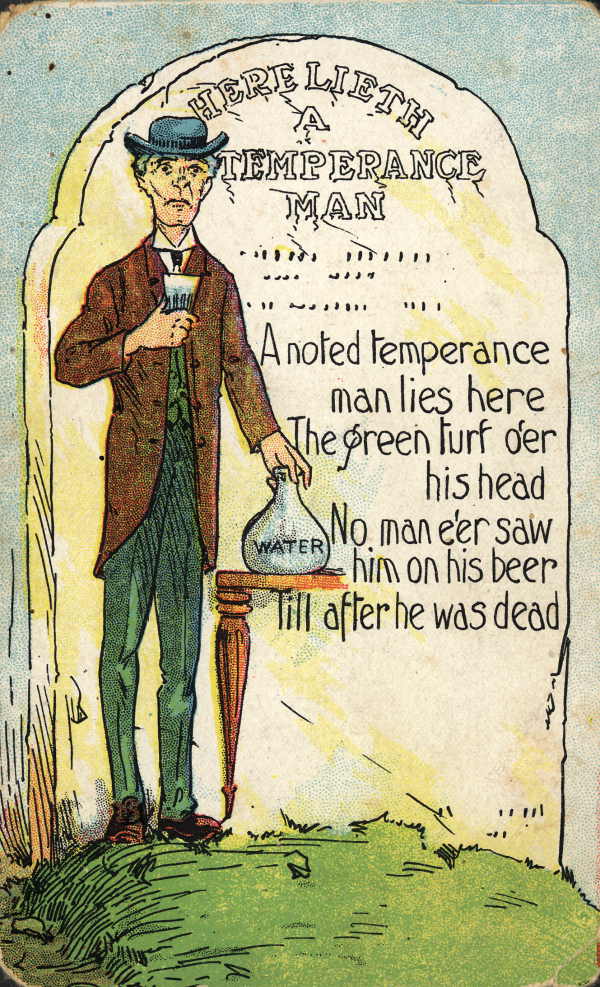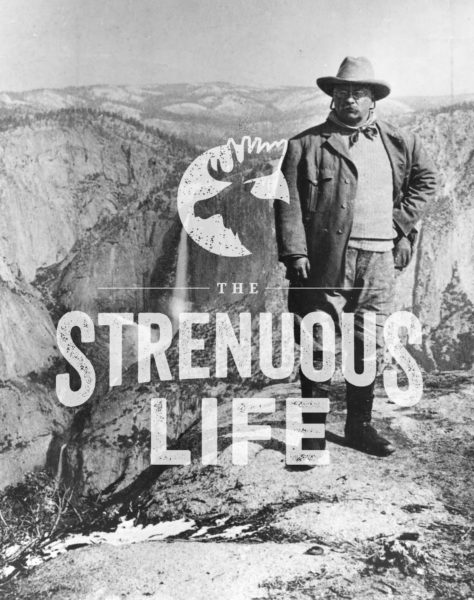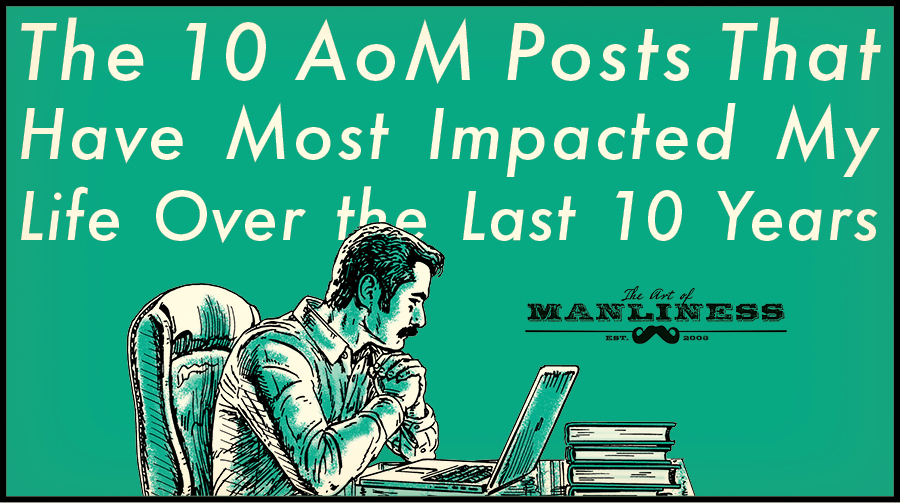
The Art of Manliness celebrates its 10th anniversary this year, and over the last decade we’ve published over 3,000 pieces of content — articles, videos, and podcasts.
When I started AoM back in 2008, I certainly didn’t consider myself an expert in manliness, and I still don’t; rather, I saw myself as a student who would be learning right alongside with readers. When it came to questions I had about how to do life better, I saw my job as digging up the best research and then synthesizing it and presenting it in a clear and accessible way. I hope that process has helped change our followers’ lives; I know for certain it’s changed mine.
With some posts, Kate and I simply sought to figure out how to articulate an idea we already had or a habit we already practiced. With others, though, researching and creating the piece actually shifted our perspective and/or led to us instituting a new habit in our lives.
Below you’ll find a list of 10 pieces of content that fall into that latter category — those that have most directly impacted my life over the last 10 years. We’ve written some super meaty and philosophical stuff over that time, such as these series on honor and the origins and imperatives of manhood, which were really interesting intellectually, but honestly didn’t impact my thinking or day-to-day life very much; they kind of fleshed out things I think most people understand intuitively but have trouble articulating. As you’ll see, the content listed below centers on ideas around behavioral or psychological shifts that can influence and improve one’s life in tangible ways. These are the posts that I still think about most, often on a daily basis, or that kickstarted some new behavior that’s still part of my life and our family’s regular routines.
Men & Status (Series)
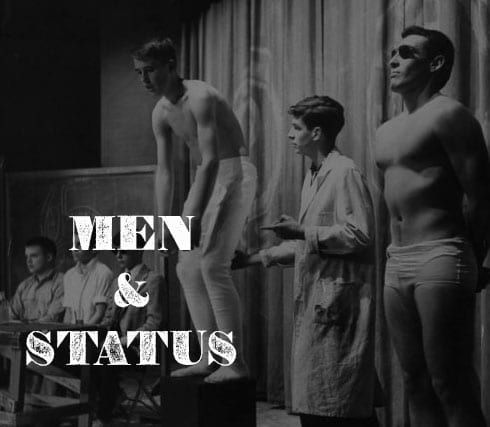
I honestly think this is our most underrated and useful series. I know, most people think they don’t, or shouldn’t, care about status — that it’s something only insecure or inferior people think about. But most people really don’t understand the nature of our innate status drive. They don’t understand how biologically and psychologically ingrained it is, how it affects them and influences their behavior even when they think it doesn’t, and how much their sense of status impacts their well-being. They don’t understand that it isn’t actually healthy not to care about the status drive whatsoever, and that it’s best to recognize you can’t wholly escape it and should rather seek to manage it in such a way as to get more of its pros and less of its cons.
The “red pill” metaphor has become so cliché and freighted with baggage that I hesitate to use it, but it really applies to reading this series. Once you understand status, you’ll become conscious of all the ways it impacts your day-to-day life — from how long it takes people to text you back to why you feel so irrationally terrible when someone snubs you. It’s amazingly revealing!
The series comes to my mind all the time, helping me to understand how and why certain interactions play out the way they do. On the downside, understanding the role status plays in relationships takes some of the fun and mystery out of them — makes them seem more biological and transactional than lofty and altruistic. But it also helps you understand why your life may not be going the way you want and what you can do to improve your status and well-being. And it’s not all selfish; understanding status can actually help you be more empathetic with folks — more cognizant of the need to push past visceral reactions to get to know the person underneath externalities.
Starting Strength Weightlifting Videos

When I first started AoM and would put out fitness content, I would invariably get comments that said things like, “If you REALLY want to give good fitness advice you need to look up Mark Rippetoe and read Starting Strength.” At the time, I honestly thought these comments were pretty annoying. They had that zealous, cult-like feel to them that made me want to roll my eyes.
Then I drank the Kool Aid myself.
First I had Rippetoe on the podcast in 2014. I started dabbling with Starting Strength, but wasn’t yet fully sold on it and kept doing the CrossFit-type workouts I had been doing for a few years. At the beginning of 2015, I drove down to Wichita Falls to film videos with Rip on how to perform the basic barbell lifts. That’s when I really bought in on barbell training. Shortly after that, I connected with Starting Strength coach Matt Reynolds for online coaching and I’ve never looked back.
Since making those videos, I’ve gotten stronger than I ever thought I would. I’m deadlifting 574 lbs, squatting 451 lbs, bench pressing 310 lbs, and shoulder pressing 210 lbs. Most importantly, strength training has become a central part of my daily life — the thing, other than my faith and family, that brings me the most enjoyment and satisfaction.
The Power of a Weekly Marriage Meeting

I saw a book about the idea of marriage meetings, was intrigued enough to read it, and figured Kate and I ought to try the concept out before writing something on the subject. A couple years after the resulting article was published, the practice remains a regular part of our lives.
The idea of marriage meetings is simple: once a week you sit down for 20-30 minutes with your spouse to get on the same page in all areas of your life. The meeting is broken into four parts: Appreciation (expressing gratitude to your spouse), Chores (making sure to-dos are getting done), Plan for Good Times (scheduling date nights, as well as individual and family activities), and Problems/Challenges (addressing conflicts/issues/changes in the relationship and in life in general). The structure of the marriage meeting is designed to rekindle your romance, solidify your friendship, nip potential conflicts in the bud, and help you smoothly run your household economy.
Kate and I honestly never make our marriage meetings happen once a week; it’s more like once a month for us. But the tool has still proven really helpful in strengthening our connection and enhancing our family life. Highly recommend all couples implementing this simple and effective habit.
Podcast With Rick Hanson on Hardwiring Happiness
I’ve battled the black dog of depression most of my adult life. I’ve had two pretty big depressive episodes, and in between them have had to grapple with an Eeyore-esque personality — I worry (a lot), think the worst case scenario will play out in most situations, and often ignore the good I have in my life in favor of focusing on the bad.
Enter Rick Hanson.
He’s a psychologist that I had on the podcast a few years ago to discuss his book Hardwiring Happiness. His main thesis is this: humans’ hardwired tendency is to go negative. It’s what allowed our ancestors to survive. And for depression-prone folks like me, this proclivity to see the glass as half empty is even worse. To mitigate that negativity bias, we need to “re-wire” our brains for resilience and happiness. You do this by simply taking a few seconds throughout the day to think about and really soak in all the good stuff you have going in your life. It’s basically a form of cognitive behavioral therapy, but it’s incredibly easy to do and the results are powerful.
After doing the podcast with Rick, I started doing the practices he outlines on his website, The Foundations of Wellbeing, and when I’m doing them regularly, the difference in my life is profound; I’m like another person — one who’s not as pissy, more productive with work, and more engaged with my family.
I highly recommend listening to the podcast — Rick lays out exactly how to do his meditative practices. It only takes a few minutes a day, but you’ll notice a benefit immediately.
My 8-Week Microadventure Challenge

The term “microadventure” was coined by Alastair Humphreys, a true Adventurer with a capital A, who wanted to get people to think of adventure outside the big, epic box we usually put the term in. Instead, he encourages folks to think small; rather than setting out on involved, far-flung expeditions, you should regularly take “microadventures” — tiny trips that butt right up against the boundary of what might be called an adventure at all, but still retain the fun, excitement, escapism, and challenge inherent to the essence of true adventures.
The beauty of microadventures is that they force you to throw out your usual excuses about why you can’t live a more adventurous life: that you live in the suburbs, lack vacation time, have kids, don’t have enough money, etc. Kate and I were guilty of making these excuses, while still longing for a bit more adventure in our lives, and so several years back we decided to take an 8-week “microadventure challenge.” Once a week for two months we had to plan and execute one microadventure. It was an incredibly fun experience that made us realize how easy is to get out and explore more, and how flimsy our imagined obstacles had really been.
Post-challenge, we don’t always manage to do a microadventure every week, but we still try to and do many more of them than we did before the challenge. It’s simply become a default mindset where we’re always thinking, “So, what microadventure are we going to do this week?”
How Manners Made the World

This is another one of our underrated articles I think. It delves into the argument made by sociologist Norbert Elias that codes of etiquette arose in tandem with democratic governments, and in fact made them possible. Basically, manners help people practice their self-control, a quality essential in citizens who wish to govern themselves. Conversely, when manners weaken, self-discipline weakens, which weakens societal and governmental institutions.
This article helped me better understand why etiquette isn’t superfluous, and the importance of manners on a whole ‘nother level, which continues to make me more motivated to practice them myself, and to instill them in my kids.
Be a Time Wizard: How to Slow Down and Speed Up Time
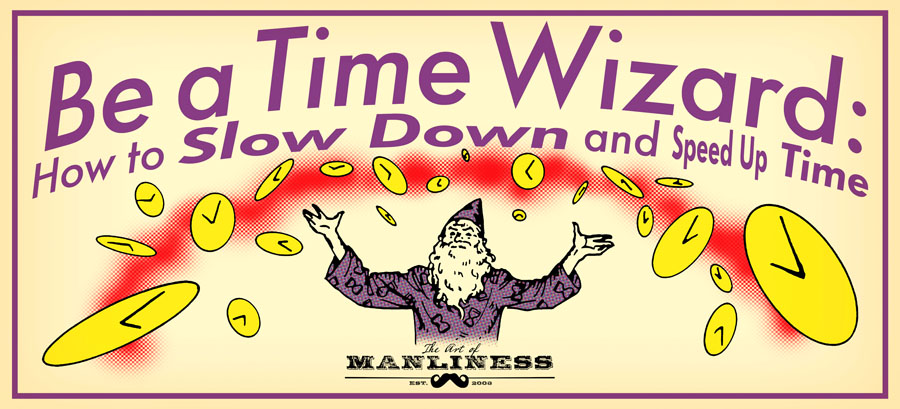
Have you ever noticed that years seemed long when you were younger, and seem to fly by now that you’re an adult? Have you ever wondered why that is? I sure did, and the research for this article not only gave me the answer, but helped me know exactly how to control my perception of time, and lengthen out how long my life feels.
The gist of the answer is that when you do new and novel things, your brain takes more “footage” of the experience to store in your memory. Then, when you think back on that period, there are more reels to unspool, which makes it feel like a longer span of time. That’s why when you’re young, and everything is new and fresh to you, years seem to stretch so far. When you do the same old things over and over again as an adult, however, your brain sees no reason to take much memory footage of what’s going on (or not going on, as it were), there’s not much reel to watch when you later recall the past, and thus the passing of time seems much shorter and quicker.
So if you want your life to slow down instead of speed by, you simply have to inject more novelty into your life. Do new things, visit new places, meet new people.
It’s a simple solution, but an incredibly powerful piece of knowledge to possess. I still think about this idea all the time, and it motivates me to try to get out of the ruts that are so easy to fall into (one tactic is taking more microadventures!). The difference is palpable: when I reach the end of a year in which I did more new things, it feels significantly longer than a year in which I mostly stuck to my routines.
Parent Like a Video Game
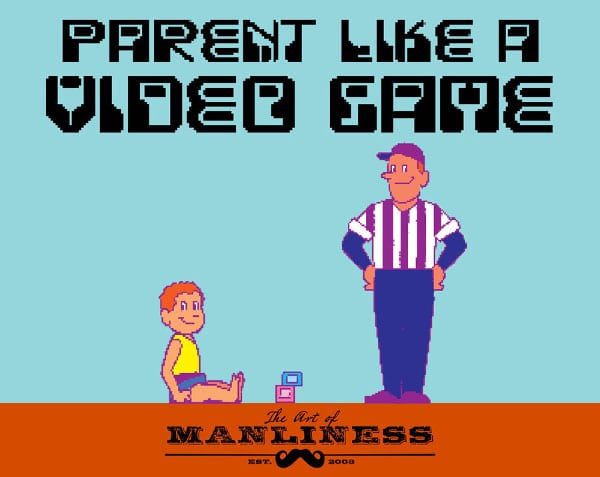
It’s can be hard to know exactly how to parent. There are a million opinions out there and even among the advice that seems sound, it can be tough to remember how to implement it, and especially to follow-through with it in the heat of a disciplinary moment!
One parenting principle that’s stuck with Kate and I, been accessible to put into practice, and seemingly proven to be quite effective, is focusing on parenting like a video game.
In a video game, the player knows exactly what to do to earn points and what dings his “life-meter,” and these rewards and punishments are doled out with programmed uniformity. Knowing the rules of the game, the player can better navigate the landscape and is motivated to get points and avoid penalties.
Using a similar principle in parenting helps encourage your child to do more of what they should and less of what they shouldn’t. You give them clear rules, and clear punishments for breaking those rules. You dole out these punishments with complete dispassion and consistency; you don’t overreact sometimes, and undereact at other times according to your mood. Input A gets your child output B. Every. Single. Time. Your kids know exactly what to expect.
You do the same thing with good behavior. If you promise a reward for doing a certain task, and they do it, you give it to them. Whenever they do something positive, they get praised.
Once your kids know the rules of the game, they’ll be able to level up their behavior.
This isn’t groundbreaking advice, but it’s the very graspable video game analogy that’s the secret sauce: it’s proven amazingly effective in helping Kate and I remember to implement these tried and true principles on a day-to-day basis.
Get Fit Like a Wild Man: A Primer on MovNat
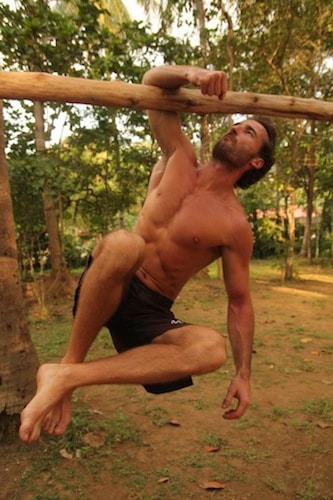
This isn’t an article that we wrote ourselves, but it kickstarted a big lifestyle change in our family and inspired several subsequent articles on the site.
Back in 2013, I got an email from a French guy named Erwan Le Corre. He said he was the founder of something called Natural Movement (MovNat) and wanted to write an article for us about how to do things like lift and carry a log efficiently.
We published the post and since then my entire family has become MovNat devotees. The philosophy behind MovNat is simple: humans intrinsically know how to physically move their bodies, and itch to do so in a wide variety of ways. But decades of fitness trends that have concentrated on counting calories, using machines, and exercising in indoor gyms, alongside an increasingly sedentary lifestyle, have left people overweight, injured, and “working out” in narrow, confined, artificial, and predictable ways. MovNat seeks to restore our knowledge of how to move naturally, and how to perform such movements in the most efficient and effective way possible.
Both Kate and I have incorporated MovNat into our respective fitness practices (I even have an online MovNat coach) and our kids participate in a weekly outdoor MovNat class. My MovNat coaching has aided my barbell training, so that I don’t turn into a muscle-bound gorilla. I’ve got super tight hips and shoulders and the programming has helped open me up for my squat and press. Plus, I just plain enjoy it!
“Do It Now!”
The “Do It Now!” maxim was just a small part of a larger article — “A Place for Everything, and Everything in Its Place” — that we did for our “Heading Out on Your Own: 31 Basic Life Skills in 31 Days” series. But it’s the tidbit that’s stuck with me the most and become something I think about often — maybe because we did a fun video around the idea, and definitely because we turned the saying into a bracelet I wear every day!
The concept could not be simpler: as soon as you think of a task that needs doing, do it! I try to think about the maxim when I’m about to leave my protein shaker in the cup holder in the car or a food wrapper on the counter, or when I keep passing a light bulb that needs changing. I’m not always able to succeed in “doing it now,” but it’s a great feeling when I am, and it keeps little to-dos from piling up into an avalanche of disorganization.
Bonus: I really wanted to stick with 10 posts for its symmetry with 10 years, but I have to also throw in a shoutout to “Shadow Work and the Rise of Middle-Class Serfdom.” Give it a read for no other reason than it debunks the very popular misconception that working hours have been going up and leisure time has been going down; it’s actually the opposite. To find out why you still nevertheless feel busier than ever, you’ll have to read the article!




